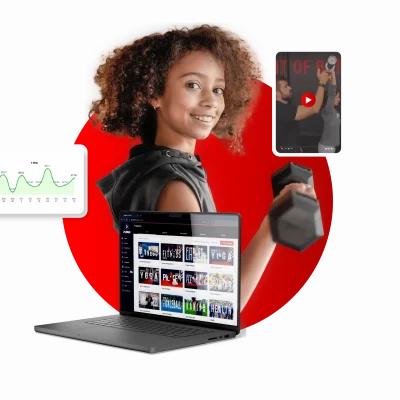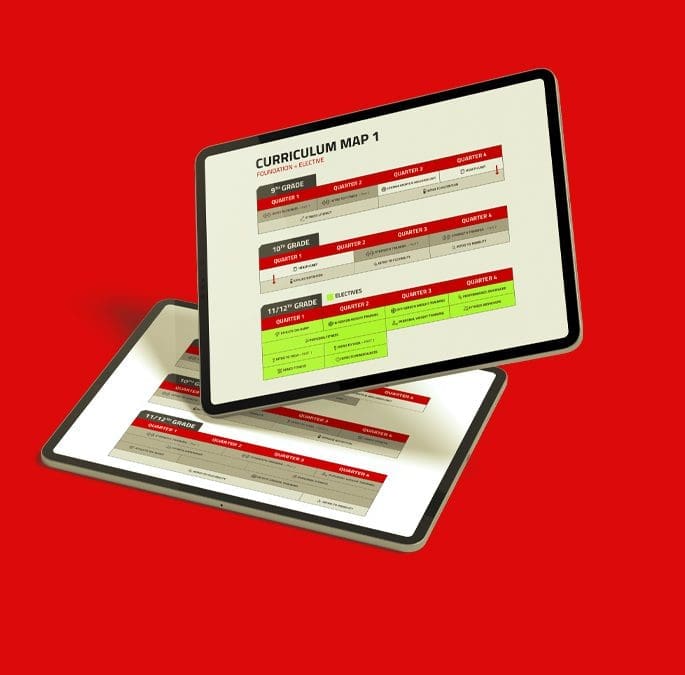There is no one set way to teach physical education. All across the country, physical education teachers tweak and adapt physical education curriculum models to support their unique group of students.
Many physical education programs have recently transitioned to a fitness education model. This article will explore considerations for physical education curriculum models and provide a fleshed-out example with a downloadable PDF.
Challenges of Planning Physical Education Curriculum Models
When planning different physical education curriculum models, it is hard to know where to start. Most physical education classes have a diverse range of students with varying interests and abilities.
Physical education programs want to find physical activity opportunities that will excite and engage students.
Historically, many schools have chosen a sport education model for students. In this model, students are exposed to different sports and games. But when sports are the primary focus throughout a semester, many students quickly lose interest.
Now, many physical education programs aim to make fitness education the focus of their physical education curriculum models. Without completely moving away from games and sports, finding a balance of fitness, sport, and other key PE content areas becomes a balancing act.
What is a Fitness Education Model?
As part of a larger physical education curriculum model, fitness education connects physical activity to overall health and wellness. The goal is that students develop the skills and interest for a sustained physically active life.
Within the world of physical fitness, there are endless content areas to choose from in a fitness education model:
Developing Well-Rounded Physical Education Curriculum Models
It doesn’t have to be all or nothing when planning physical education curriculum models. At PLT4M, we work with over 1,500 school districts and have seen PE teachers masterfully blend fitness, sport, health, and wellness all into one curriculum.
The end result allows more students to actively participate in physical education and explore new physical activity opportunities.
To help give fellow PE teachers a better sense of what different physical education curriculum models can look like, our team created “Playbooks.” Playbooks personify some of the most common physical educator experiences and give an inside look at what a curriculum implementation can look like.
Fitness & Strength Physical Education Curriculum Models
This playbook is for any physical education instructor teaching either 9th grade PE, strength classes, or both. This playbook covers fitness & strength curriculum ideas, setting up classes, registering students, and reporting on progress.
Meet Sue!
- Sue is a high school P.E. teacher in Arizona
- Her school just signed up for PLT4M, and the P.E. chair has invited her and the other P.E. teachers in the department to create a PLT4M account
- Sue teaches two PE9 classes, as well as two elective weight training classes. Both meet 5x per week, for 45 minute classes
- Sue also coaches Field Hockey
Before PLT4M
Sue has been teaching Phy Ed for 10 years. Historically, Sue has taken her classes through several different activity units. This year, her department is beginning to transition to a fitness based approach. She is eager to find resources to help her develop a fitness-based curriculum, and she’d also like to provide the students and her department with real time progress data.
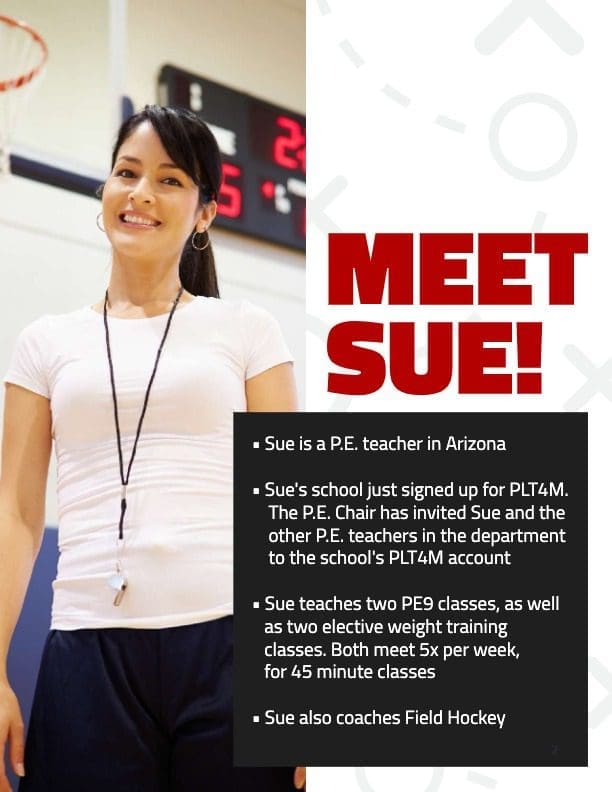
Groups
Now that her account is created, she navigates to the GROUPS page to set up her classes. Sue creates a group for each class. This will allow her to differentiate program assignments per class, and will also help her organize her progress reports by class.
When labeling her groups, she includes the period, class name, and her name, so students can easily identify and join their groups.

Program Selection
Next, Sue spends some time reviewing the PLT4M Program Guide to help her decide which programs best suit her classes. For her PE9 classes, she wants something very introductory that doesn’t require much equipment. For her elective weights classes, she’s unfamiliar with the backgrounds of the students in these classes, so she wants to spend time reviewing proper form and technique on all core lifts. This will also give her time to assess the students ability levels early on in the semester.
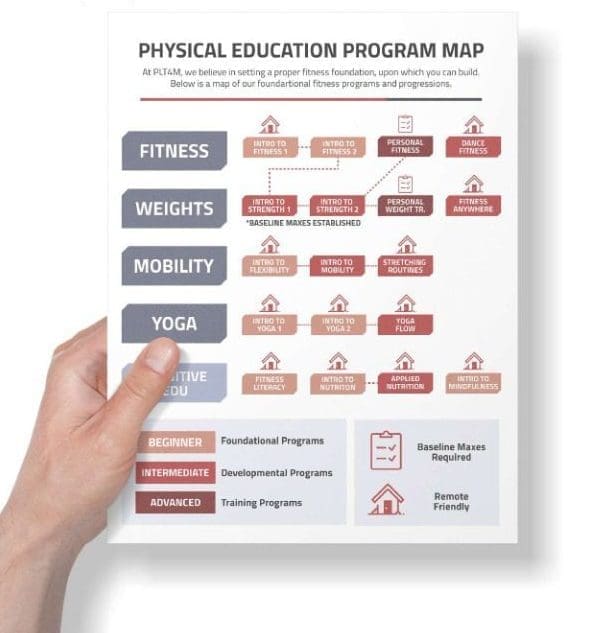
After viewing the Program Map, she decides that the Intro to Fitness Part 1 program would be a great place for her PE9 classes to start. She loves that this program is mostly bodyweight, and provides every student with a foundation of human movement (squat, lunge, hinge, push, pull).
For her elective Weights class, she considers the Intro to Strength Part 1 & 2 programs. These programs provide an introduction to the Squat, Bench, Deadlift, Clean, and Press, with a huge emphasis on form, technique, and safety. The Intro to Strength programs also conclude with baseline max testing weeks, which will give her a baseline for student progress. The goal will be to advance students into a program such as Personal Weight Training—where students can find individually prescribed weight loads.
Sue considers supplementing training with program such as Stretching Routines and Nutrition.
She creates an outline for her plan:
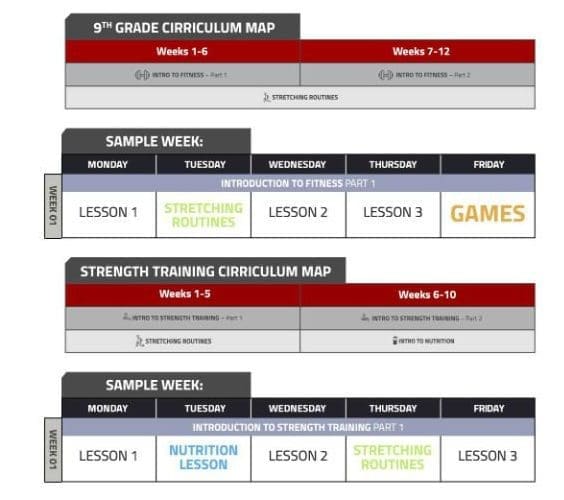
Weight Room Logistics
Once students have registered, joined groups, and have access to their program assignments, Sue takes time to figure out how she’ll run her classes.
For her PE9 classes, she plans to project the workout videos, and watch them as a group. When the students are asked to complete certain movements and sets, the class will break apart and complete the work, reconvening for the next video instruction. This will allow Sue to reiterate certain coaching cues to the group, and ensure that each student receives the foundational movement education.
For her Weights classes, she believes this group is self-sufficient, having already gone through an introductory program. She plans to have students access the workouts through their preferred devices (tablets or mobile phones). This will free up Sue to act as a float and provide 1:1 coaching and corrective cues where needed.
If too many devices are scattered around the weight room, she’ll encourage students to use Rack View to minimize the amount of devices in the weight room.
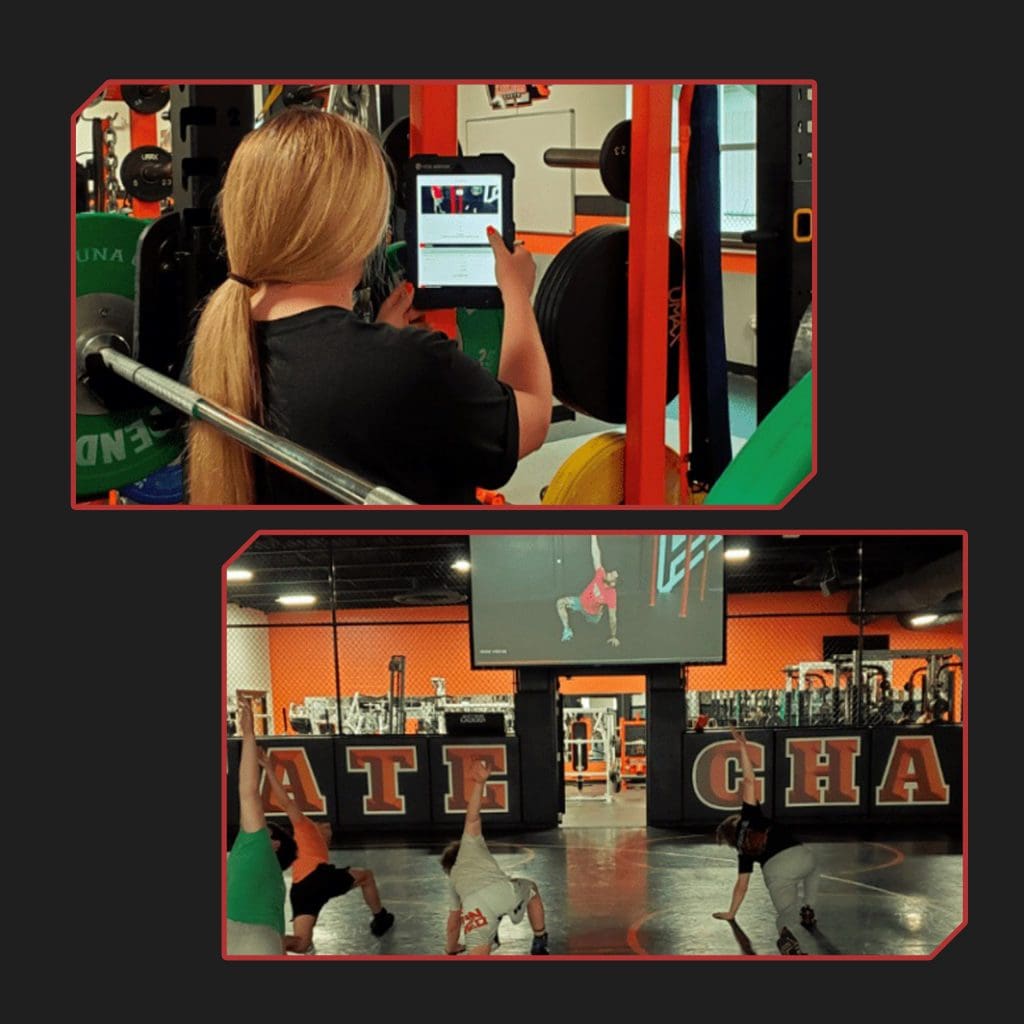
Activity Tracking & Progress Data
Sue checks her program outline to identify what assessments are being collected, and when. After finishing Intro to Fitness Part 1 and Intro to Fitness Part 2, the PE9 classes will have completed a set of fitness assessments at week 5 and week 10. Sue plans to create a Report Card to include progress data for these fitness metrics:
- 1 Mile Run
- Push Up
- Pull Up
- Air Squat
- Squat Mobility Test
- 2 Min Burpee Test
- PlankHold
- PLT4M Metcon
This report will show Sue an overview of the progress made in each performance metric among her two classes, as well as an individual student breakdown for each metric. This data will help guide feedback conversations Sue plans to have with all of her students.
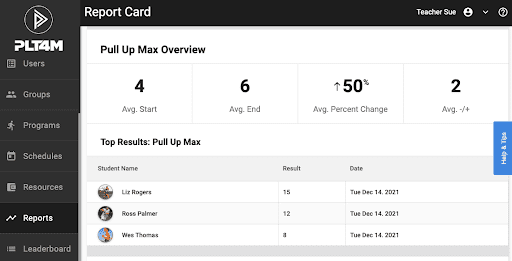
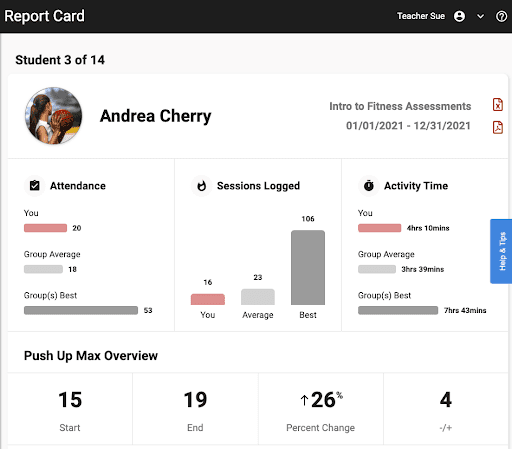
Participation Report
Since the elective Weights classes are spending most of their time learning proper lift form, assessments (max tests) don’t take place until the end of each program. For this reason, Sue decides to track their workout activity instead. Since the students are expected to log and complete workouts independently, Sue plans to use this data as part of their participation grade.
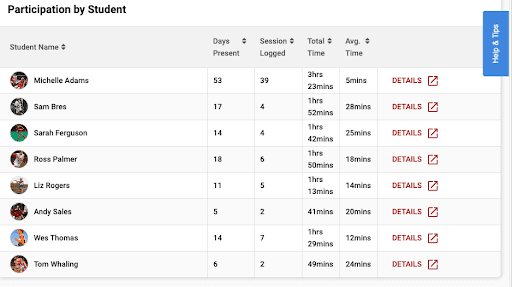
Final Thoughts on Fitness Focused Physical Education Curriculum Models
With access to PLT4M’s programs and resources, Sue now feels much more confident in her lesson plans.
She notices that her students have developed a common language of fitness, making it easier to provide coaching and refer to certain movements.
The students who have completed the Intro To Fitness series in 9th grade PE are already expressing interest in the elective weights class. The Intro To Fitness program has helped break down any barriers previously keeping students from trying out a weight lifting class, since they now feel confident in their movement patterns. Students who’ve completed the Intro to Strength series are motivated to keep progressing in their max lifts.
In prior years, Sue’s grading technique was largely subjective. Now, Sue has access to concrete progress data to help her evaluate her students.
After 12 weeks following PLT4M’s programs, Sue is able to export progress data in all of her fitness assignments. Based on the growing popularity of her weights PE class, and the progress data she has presented to her PE chair, her department in full support of the transition to a fitness based PE curriculum.
Want To Spice Up Your Curriculum?
Schedule a 15-Minute demo to learn how PE teachers are ushering in a new age of Physical Education with Fitness and Technology!
